Last updated: June 17, 2024
Article
What Ten Years of Vegetation and Soils Monitoring Reveals at Dinosaur National Monument
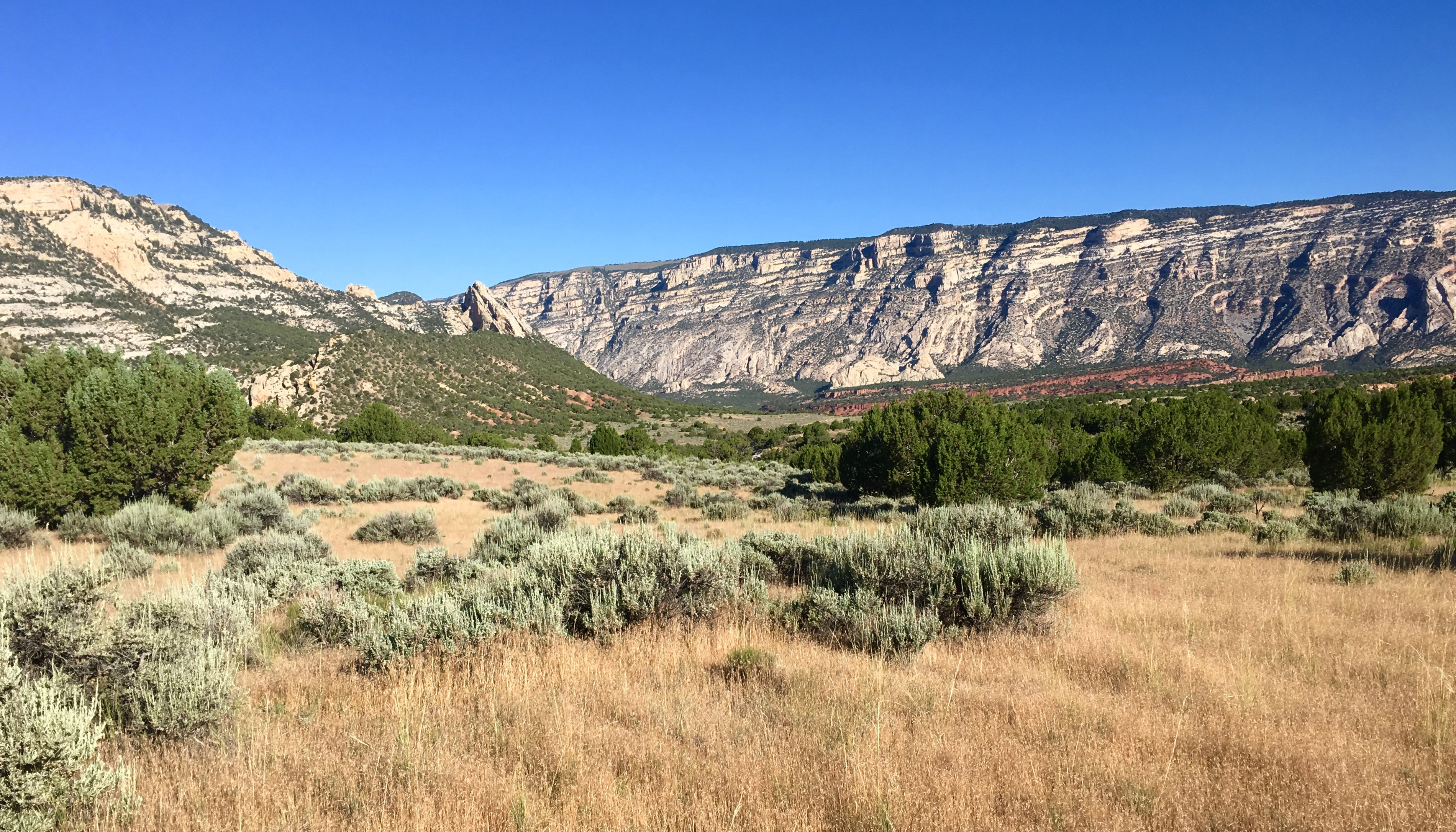
Pinyon-juniper woodlands interface with sagebrush communities in Dinosaur National Monument.
NPS / Amy Washuta
Key Findings
- Multiple indicators suggest that plant community change is taking place in sagebrush ecosystems at Dinosaur NM.
- There was a rapid, increasing trend in exotic cover and frequency across 10 years of monitoring.
- Pinyon-juniper woodlands were in generally stable condition in the area monitored, but a decreasing trend in the density of saplings may be of concern.
Overview
At Dinosaur National Monument (NM), sagebrush-steppe shrublands and pinyon-juniper woodlands are full of life. They support diverse ecosystems and provide valuable ecosystem services, including soil stabilization, fire resistance, water conservation, and wildlife habitat. But these landscapes are not static paintings—they are dynamic tapestries, constantly evolving in response to environmental changes and human activities.
Ecosystem services are biological benefits provided to humans or other living things by the presence of healthy ecosystems. Essentially, they are outputs of natural processes. These processes provide desired outcomes that benefit humans, and we don't have to try to replicate the natural processes to thrive or survive. For example, trees convert carbon dioxide into oxygen, and offshore mangroves absorb the impacts of extreme weather events.
Across the US, intact sagebrush ecosystems provide habitat for more than 350 plants and animals of conservation concern. Domestic livestock also use them as forage. But sagebrush-steppe shrublands are considered one of the nation's most threatened ecosystems, due to habitat fragmentation and conversion to other vegetation types. These include pinyon-juniper woodlands and grasslands dominated by invasive annual plants.
Sometimes, pinyon pine and juniper trees are shrubland invaders. But these woodlands also provide ecosystem services, such as plant materials for cultural use and habitat for sensitive species. They are experiencing dieback and mortality related to drought stress in some areas. At Dinosaur NM, research has suggested contraction of this community.
Since 2009, the Northern Colorado Plateau Network has monitored change in these vegetation communities, and in the soils where they grow. A new report summarizes 10 years of monitoring and puts the results in the context of multiple ecological drivers. The report also provides management recommendations. Studies like these help us better understand the health of park ecosystems. This report and others like it offer park managers information they need to make key stewardship decisions.
“We found some surprising and encouraging results related to soil conditions but were concerned to see the decline in native grasses in combination with rapidly increasing cheatgrass."
—Carolyn Livensperger, NCPN ecologist
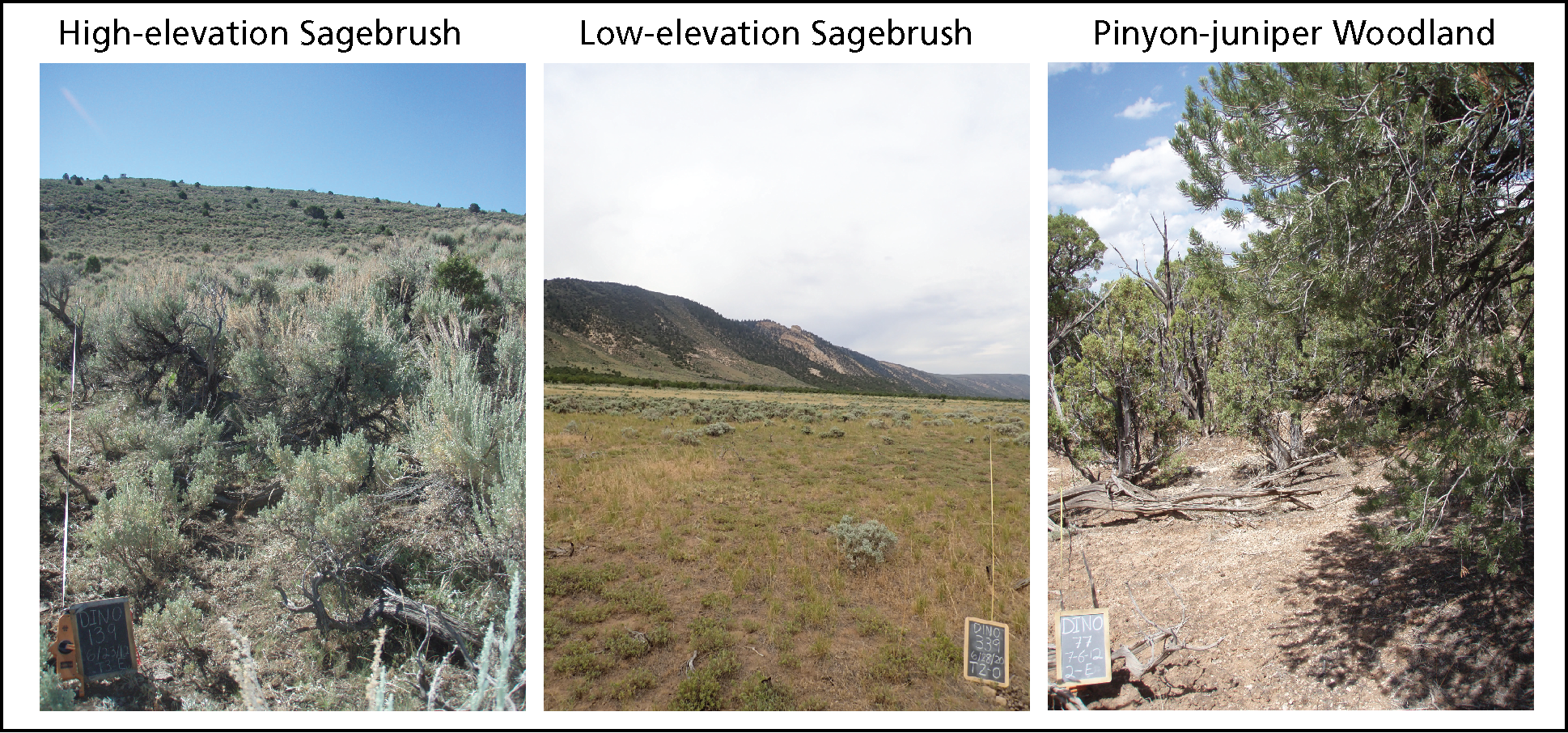
Sampling areas (high-elevation sagebrush, low-elevation sagebrush, pinyon-juniper woodland) at Dinosaur National Monument. NPS photos.
What We Did
At Dinosaur NM, NCPN monitoring of vegetation and soils aims to answer two questions:
- What is the status and trend of vegetation and soil indicators for high-elevation sagebrush, low-elevation sagebrush, and pinyon-juniper woodland communities? and
- How do climate, grazing, and fire history influence observed status and trend?
To find out, field crews record the condition of several parameters across about 36 plots each year: sagebrush cover, live perennial grass cover, exotic annual cover, tree cover, biological soil crust cover, and soil stability. With a total of 135 monitoring plots, it takes five years to complete one monitoring rotation of the entire monument.
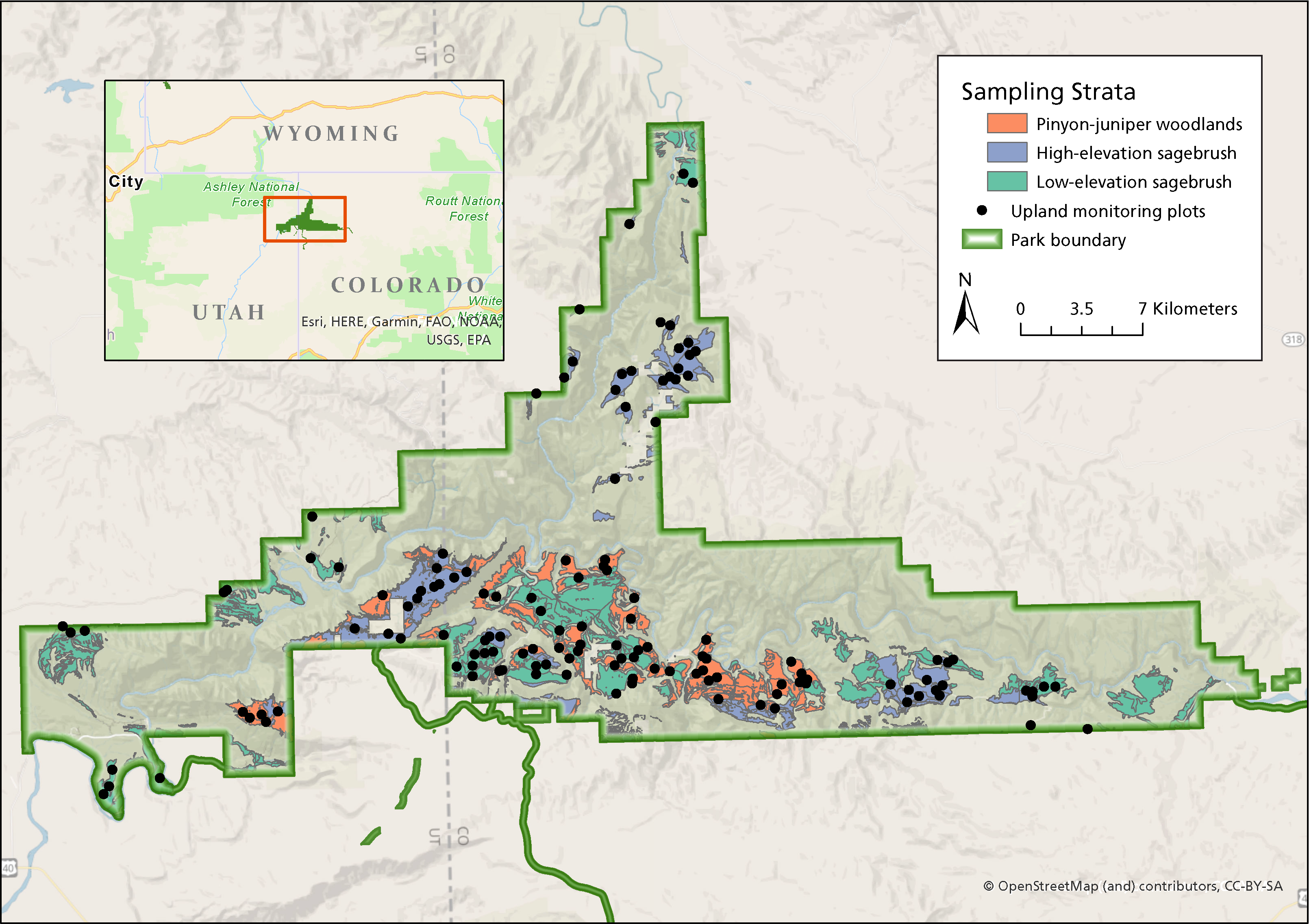
Location of upland vegetation monitoring plots and sampling strata at Dinosaur National Monument.
2010–2020: What We Found
The following results are summarized in Table 1.
Cheatgrass:
- Is an invasive grass species.
- Outcompetes native vegetation, forming dense monocultures.
- Increases the frequency and intensity of wildfires.
- Can alter ecosystem dynamics and lead to a decline in biodiversity.
Sagebrush systems
- In both high-elevation and low-elevation sagebrush communities, native cool-season perennial grasses are decreasing. Meanwhile, exotic annuals are increasing rapidly. Cheatgrass (Bromus tectorum) is leading the way. Exotic annual plants increase rapidly, and in the sagebrush communities monitored in Dinosaur NM, this finding is of significant concern. The dominant exotic annual species is cheatgrass, which has spread following fires in the past, particularly low-severity fires followed by dry conditions. Cheatgrass has now been detected in over 25% of the park.
- The cover of big sagebrush (Artemisia tridentata) at both high and low elevations was slowly increasing, while high elevations saw increasing density of mountain big sagebrush (A. tridentata spp. vaseyana), which indicates some successful recruitment.
- At both high and low elevations, soil-surface indicators were mostly stable or improving.
- Biological soil crust cover was increasing—a surprising result, given that weather conditions during the study period were not generally favorable to their growth. However, bare soil cover was increasing in high-elevation sagebrush, which could lead to increased erosion.
Pinyon-juniper woodlands
- Pinyon-juniper woodlands comprise the majority of plant communities throughout the monument.
- Monitoring results did not show an increase or decrease in tree cover in either pinyon-juniper woodlands or sagebrush shrublands. This suggests that tree cover is stable in the area monitored—but sapling density was decreasing in pinyon-juniper woodlands. Future monitoring will include an additional measure of tree crown health with the goal of detecting dieback.
- Exotic species cover in pinyon-juniper woodlands was low (<10%) and stable over the monitoring period. But the rate of exotic frequency detections was increasing. There is potential for invasion from adjacent sagebrush sites with high cover of exotics.
- The condition of soils in these pinyon-juniper woodlands may reflect limited disturbance in this area.
Table 1. Condition (color), direction of condition (arrow), and confidence level (outer line) for key vegetation and soil indicators at Dinosaur National Monument, 2010–2020.
|
Parameter |
High-elevation Sagebrush |
Low-elevation Sagebrush |
Pinyon-juniper Woodland |
|
Big sagebrush cover |
|
|
|
|
Perennial grass cover |
|
|
|
|
Exotic annual species cover |
|
|
|
|
Tree cover |
|
|
|
|
Biological crust cover |
|
|
|
|
Soil stability rating |
|
|
|
Note: Colors indicate whether the current condition is Good (green) of Moderate Concern (yellow), or of Significant Concern (red). Arrows indicate whether the condition is improving, declining, or stable. The outer ring of the circle indicates the level of confidence in the assessment, where a solid line is medium confidence, and a dashed line is low confidence. Direction of condition is not always the same direction of analyzed trend. For more complete information, see Tables 1 and 4 in the report.
Influence of Climate, Fire, and Grazing
NCPN monitoring studies contextualize observed trends with other drivers. Considering various drivers and their interactions over time helps us better understand the mechanisms of change in the environment. Drivers in high- and low-elevation sagebrush shrublands and pinyon-juniper woodlands include natural and prescribed fires, and grazing, both livestock and native ungulates. Favorable conditions and climatic stress are both drivers influencing environmental change. Each community may respond to these disturbances differently.
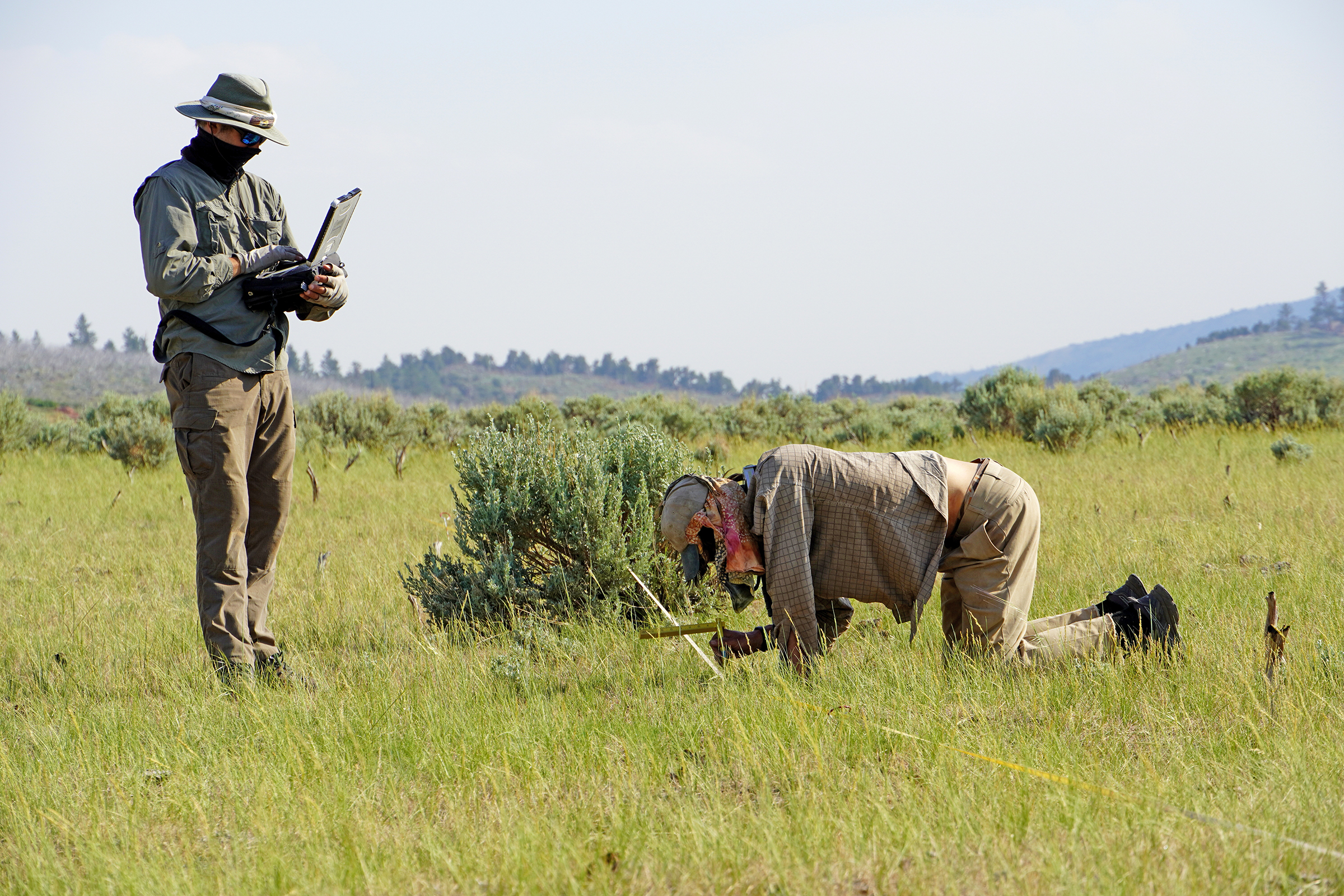
Research scientists reading gaps in a field of grass, Dinosaur National Monument. Gaps between plant canopies and plant bases inform us about the ability of the system to buffer against wind (canopy gaps) or water (basal gaps) erosion. Generally, larger gaps indicate greater potential for soil erosion. NPS / Amy Washuta.
As the climate warms, Dinosaur NM has experienced greater maximum and minimum temperatures, warmer winters with loss of snowpack, and an increase in extreme precipitation events. The warming temperature trends are projected to continue. Warmer winter temperatures have led to a longer growing season, which impacts vegetation community dynamics.
Sagebrush communities have been impacted by fire and grazing in the past. Some areas have converted to grasslands, which can be dominated by native or exotic species. Fire suppression may allow pinyon-juniper woodlands to encroach into sagebrush communities —but more frequent fire often leads to invasion by exotic annual grasses. Although this analysis could not isolate the impacts of fire and grazing, results suggest they play a role in combination with other factors. For example, cheatgrass invasion and increased human use may have altered fire regimes in Dinosaur NM beyond what they were in the past. Projected increased fire frequency due to climate warming may reduce the stability of sagebrush ecosystems. Where there is already an increase in the presence and cover of exotic annuals (such as at Dinosaur NM), sagebrush communities may undergo an irrevocable transition into exotic annual grassland communities due to fire. In response, managers may choose to focus their protection efforts on sites with low but intact native plant communities.
What we learn from science in the national parks informs management decisions and policy. It helps us understand how natural systems work and how they respond to stress. By measuring change, understanding the drivers of that change, and identifying pockets of resilience and vulnerability, we can make better decisions for resource conservation.
"This work is an excellent example of why long-term monitoring is useful to park managers. We now have not only a baseline, but also trends for conditions in these key uplands with strong responses to climate drivers. This information can aid in decisionmaking on topics including climate change, grazing, and fire management."
—Dusty Perkins, NCPN program manager
Management Recommendations
Based on the results presented in this report, the NCPN recommends the following for management of high- and low-elevation sagebrush and south-central pinyon-juniper woodlands of Dinosaur NM:
- Prioritize control of exotic annuals, particularly cheatgrass, which are rapidly increasing in high- and low-elevation sagebrush. Because control and restoration of cheatgrass-invaded areas at a landscape scale is often not feasible, managers could focus on preventing further spread through limiting disturbance by fire, especially in areas of low resilience that have not already been invaded.
- Concurrent with exotic species control, native cool-season grasses that are declining in cover should be protected. Strategies to accomplish this could include limiting disturbance by fire, reducing the intensity of grazing, or altering the timing of grazing to protect the spring growth period of cool-season species.
- Where high- and low-elevation sagebrush are protected, consider active restoration of cool-season grasses. Restoration efforts could include seeding or planting of native species in combination with surface modifications to stabilize soil and retain soil water.
- Monitor the status of pinyon and juniper saplings, which are decreasing in density and have been identified as vulnerable to drought in the region.
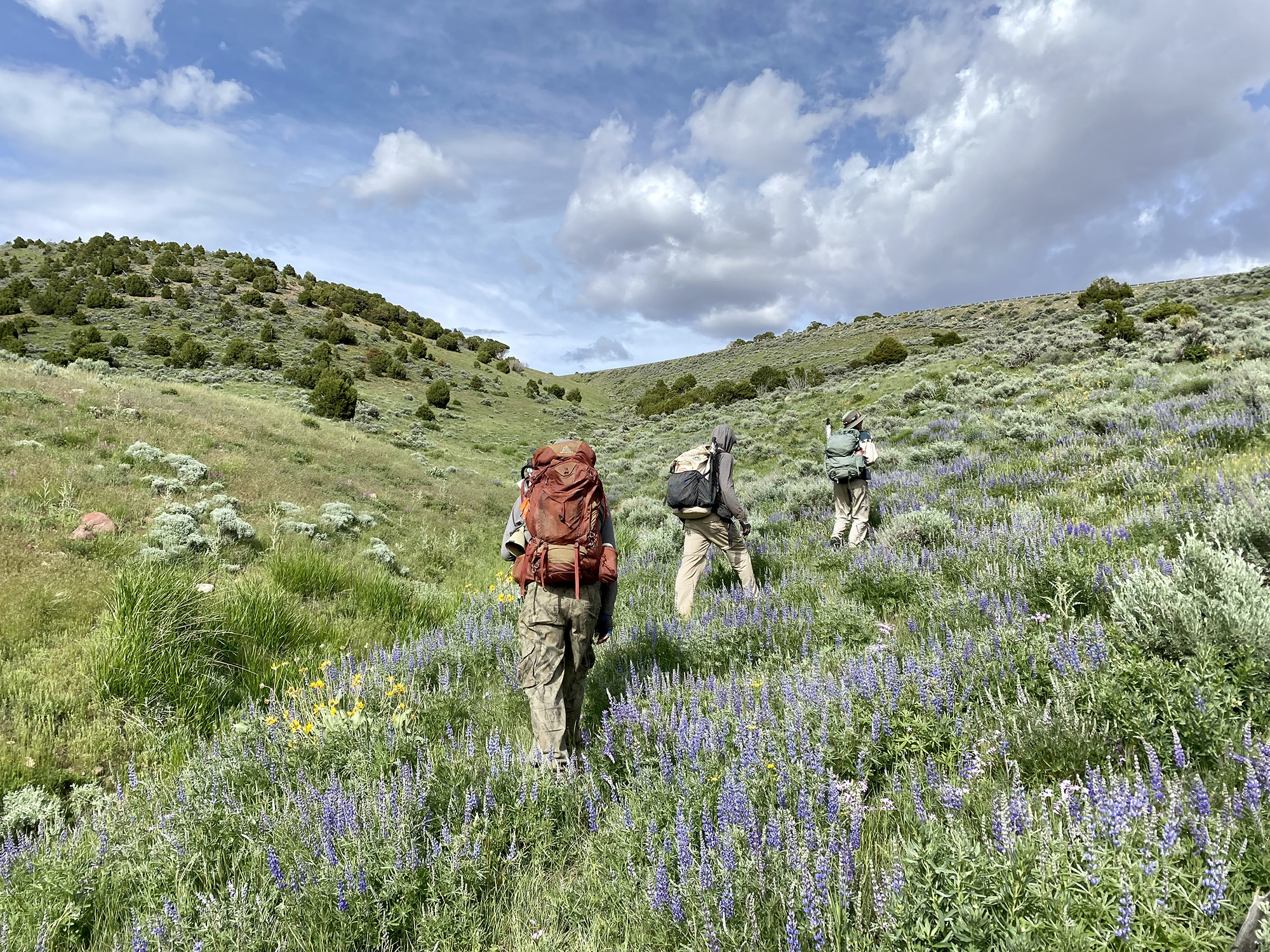
Hiking to a high sagebrush plot near Harpers Corner, Dinosaur National Monument. NPS / Amy Washuta.
Information in this article was summarized from Status and trend of upland vegetation and soils at Dinosaur National Monument, 2010–2020, by Carolyn Livensperger and Dana Witwicki, https://doi.org/10.36967/2302751.









